The Appraisal
Amrita Sher-Gil Was a Visionary Modernist. But Export Rules Are Complicating Her Market Surge
Her short life and status as one of India's national treasures make artwork extremely scarce.
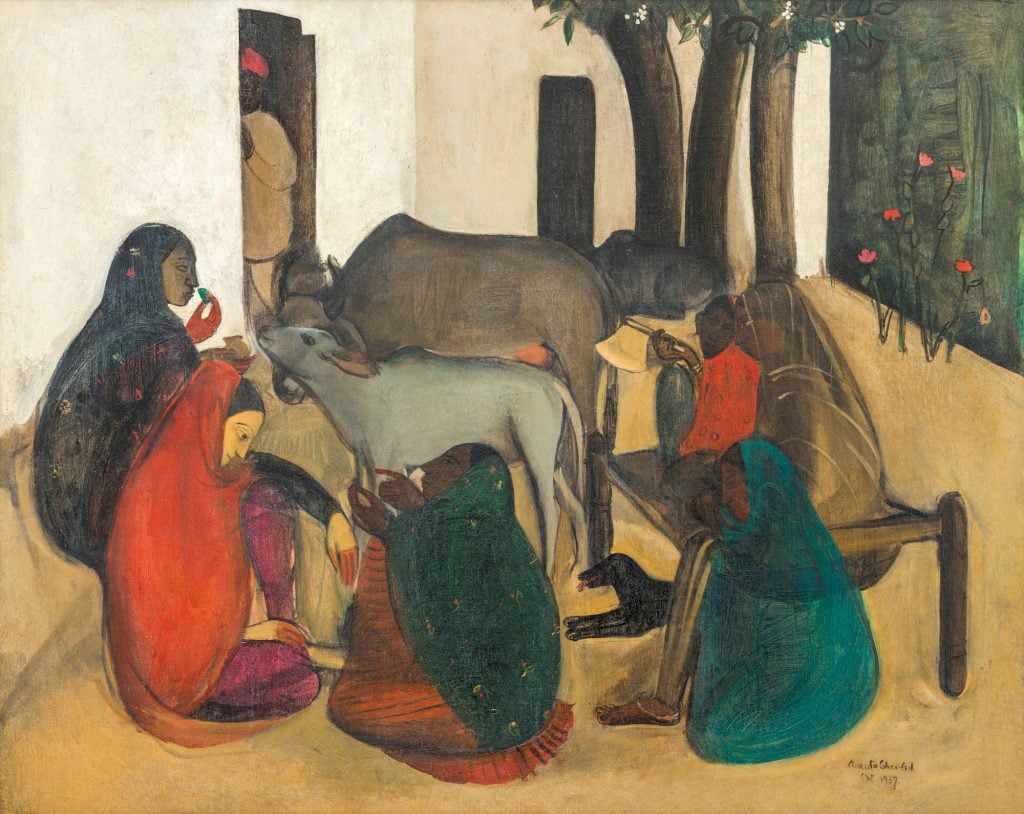
Her short life and status as one of India's national treasures make artwork extremely scarce.

Eileen Kinsella

During Amrita Sher-Gil’s brief but intense lifetime, the Hungarian-Indian artist tirelessly embraced her passion for painting, creating groundbreaking Modernist paintings that have influenced successive generations of painters and garnered intense market demand that far outstrips supply.
Her work also catapulted her to become the only woman in the group known as the Navaratnas, the nine artists who are renowned as national treasures. “It seems to me that I never began painting, that I have always painted,” the artist once said. “And I have always had, with a strange certitude, the conviction that I was meant to be a painter and nothing else.”
Recent inclusion of her work in the 2017 edition of documenta in Kassel, Germany, and in this year’s Venice Biennale have spotlighted the work anew and introduced her to a wider audience. But it’s not as if this is the first time the art world has sat up and taken notice. Sher-Gil was the focus of a major exhibition at London’s Tate Modern in 2007.
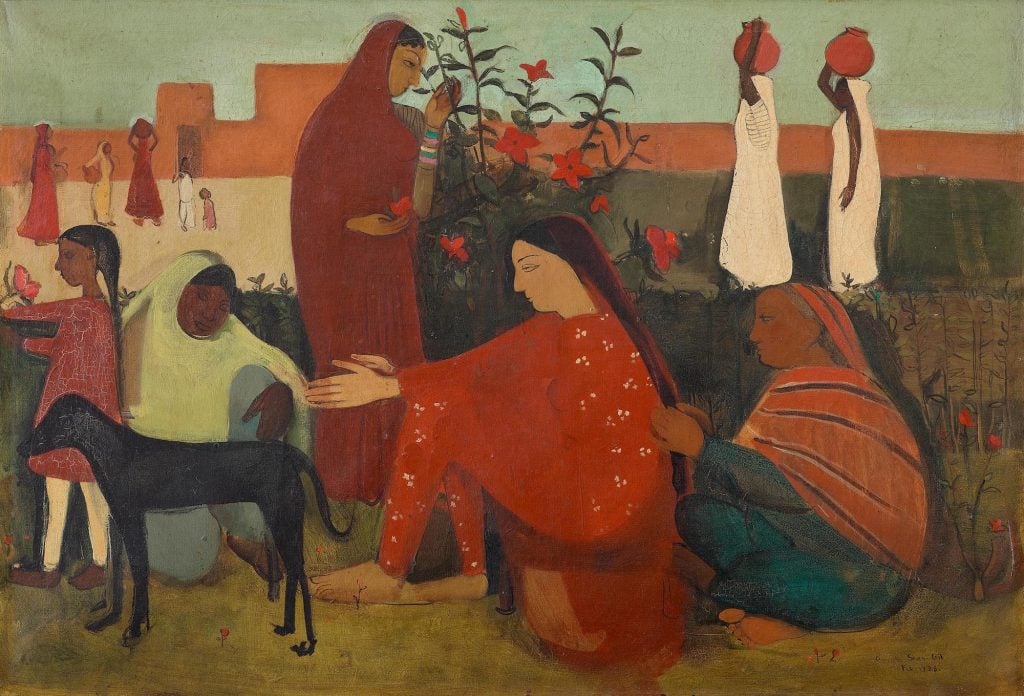
Amrita Sher-Gil, In The Ladies’ Enclosure (1938). Courtesy Saffronart.
Sher-Gil was born in Budapest in 1913 to an Indian father and a Hungarian mother, and her talent as a painter was evident from a young age. As a child she lived in India and Europe, attending the École des Beaux-Arts in Paris at the age of 16, where she was influenced by the work of Paul Cézanne, Paul Gauguin, and Amedeo Modigliani. She left Paris for India in 1934, when she was already gaining recognition for her paintings.
“She was very intrigued by the everyday persona,” said Minal Vazirani, co-founder of auction house Saffronart, in a phone interview from Bangalore. “She began moving a little later into portraits of women and women engaged in everyday ritualistic practice in semi-rural India. She has ladies in their toilet, showing women getting dressed and grooming themselves.”
Saffronart, which specializes in Indian and South Asian art and antiquities, holds two of the highest auction prices achieved for the artist. Due to her brief life—the artist died at the age of 28—her output is scarce. The Artnet Price Database lists just 92 lots that have come to auction. Just 10 of those were bought in, for an overall sell-through rate of 89 percent. Notably, all the works offered in 2023, the most on offer in three years, found buyers.
The Context
Auction record: $7.4 million at Saffronart in New Delhi in September 2023
Performance in 2023:
Lots sold: 10
Bought in: 0
Sell-through rate: 100 percent
Total sales: $7.9 million
Top painting price: $7.4 million
Lowest painting price: $581,674 for a 1932 oil on canvas, Untitled (Hungarian Village Church)
Lowest overall price: $314, for A Farkas Khan Leanya (The Daughter Of The Wolf Khan), a watercolor on paper sold at AstaGuru in Mumbai on June 24, 2022
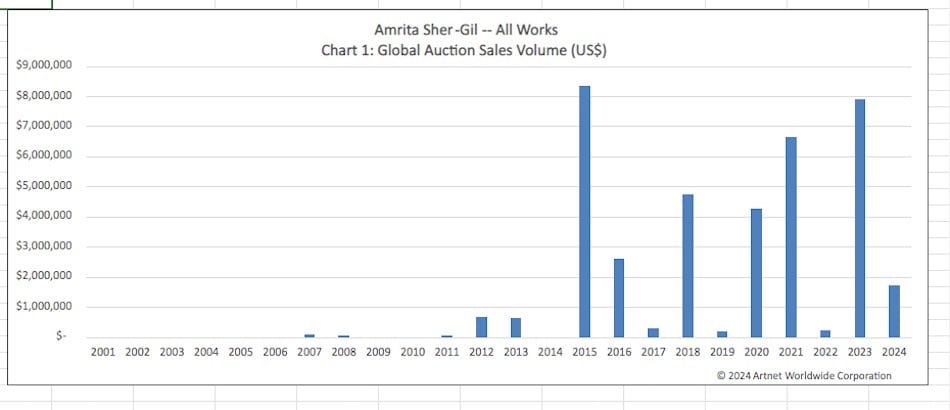
Global auction sales of artwork by Amrita Sher-Gil. Source: Artnet Price Database
Expert View: “In life and art, Amrita Sher-Gil was avant-garde,” said Ishrat Kanga, Sotheby’s co-worldwide head of modern and contemporary South Asian Art, London. “Both Hungarian and Indian, she was a harbinger of Modernism in Indian art, and in her lifestyle, an icon of the modern, independent woman.”
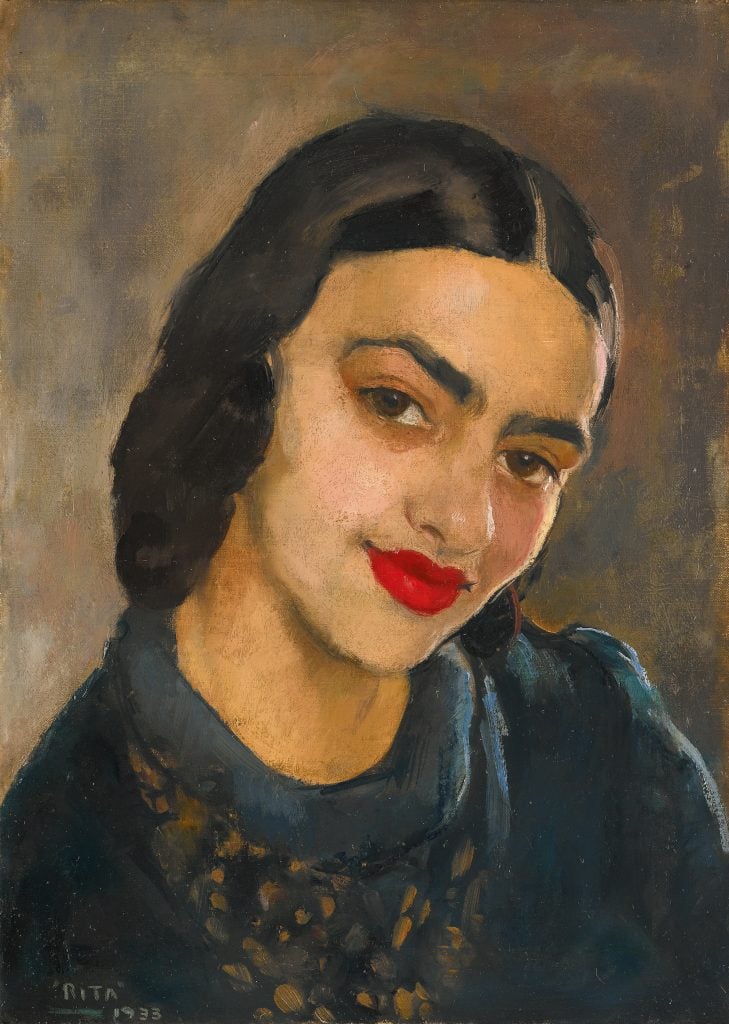
Amrita Sher-Gil, Untitled (Self Portrait) (1933) . Image courtesy Sotheby’s.
Sher-Gil “embodied a bohemian combination of East and West, not aligning with a particular school or style of painting and straddling both worlds,” said Kanga. Noting that the current Venice Biennale, “Foreigners Everywhere,” gets its title from an Italian artist collective that fought racism and xenophobia, Kanga says Sher-Gil “must have experienced [this] her whole life, growing up as a woman in the early 20th century and being considered a foreigner in her mother’s homeland, Hungary, and a foreigner in her father’s country, India. Hence her inclusion is particularly apropos, given the theme and current times.”
Saloni Mathur, who delivered a lecture this past November at the Seattle Art Museum, described her first experience on seeing Sher-Gil’s Self Portrait as a Tahitian (1934), in which the artist is topless and wears a white sarong wrapped around her waist. “I remember experiencing a sense of vertigo after first encountering this painting in response to the dizzying set of questions it raised. What were the conditions that made possible such an account of Gauguin by a non-Western woman in 1934? What precisely was meant by Sher-Gil’s self-conscious placement into the body of a Tahitian nude? And how could art history have missed this painting, so deliberately a citation of art historical precedent?” Mathur said.
A key market moment happened in 2015, when Sotheby’s sold the artist’s 1933 work Untitled (Self Portrait) for $2.9 million. It was the first time in history that one of her paintings was estimated over $1 million, and it nearly tripled its estimate, setting a new benchmark and “putting Sher-Gil into a tight pool of Indian artists to have achieved prices of seven figures for an artwork at auction. Today, Sher-Gil is the highest selling Modernist Indian artist of all time,” said Kanga.
Sotheby’s Mumbai sold The Little Girl in Blue (1934) for $2.7 million in November 2018. And Saffronart sold In The Ladies’ Enclosure (1938) for $5.1 million in July 2021. To date, 12 works have sold at auction for above $1 million each.
Sher-Gil “is an amazing part of history,” said Vazirani, of Saffronart. “There’s a certain enigma to her. She wasn’t from India but certainly made India her own, both in terms of artistic process and her subject matter.”
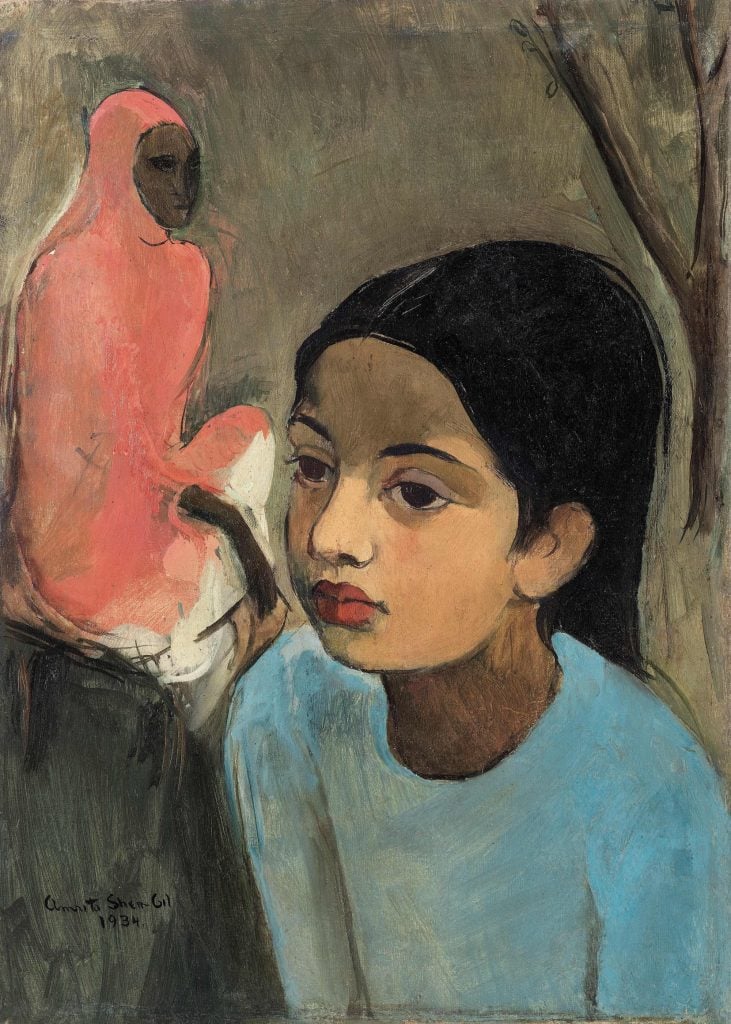
Amrita Sher-Gil, The Little Girl in Blue (1934). Image courtesy Sotheby’s.
The artist lived such a short life, notes Vazirani, but “during that time created some of the most important works of Indian art. She broke out of many of the boundaries and rules that were set at the time in terms of her innovation and she also she came out of that period becoming a key influence for the artists that followed. There is no question that some from the Progressive Artists Group were keenly influenced by her. Collectors, curators, writers, and institutions are all fascinated by her.”
The Appraisal: To date, 12 works of the 92 offered have sold at auction for above $1 million each. There is such a dearth of material available due to her short life and the current intense demand that there is really no distinction between private market prices and those achieved at auction. Nor does it matter what period or subject matter the work is in terms of market demand.
“Prices are significant regardless of how or where they are sold,” said Kanga of Sotheby’s. “There aren’t a lot of paintings by her, so every single work is in demand, no matter which period it is from.”
The Artnet Price Database lists numerous watercolors, charcoals, and pencil-on-paper works that sold for under $100,000. Most of her major paintings have been sold via auction, and many of those were in India.
Due to Sher-Gil’s status as one of India’s top artists, export restrictions are understandably strict. A note in all caps accompanies the top-selling painting on Saffronart’s website: “NON-EXPORTABLE NATIONAL ART TREASURE.”